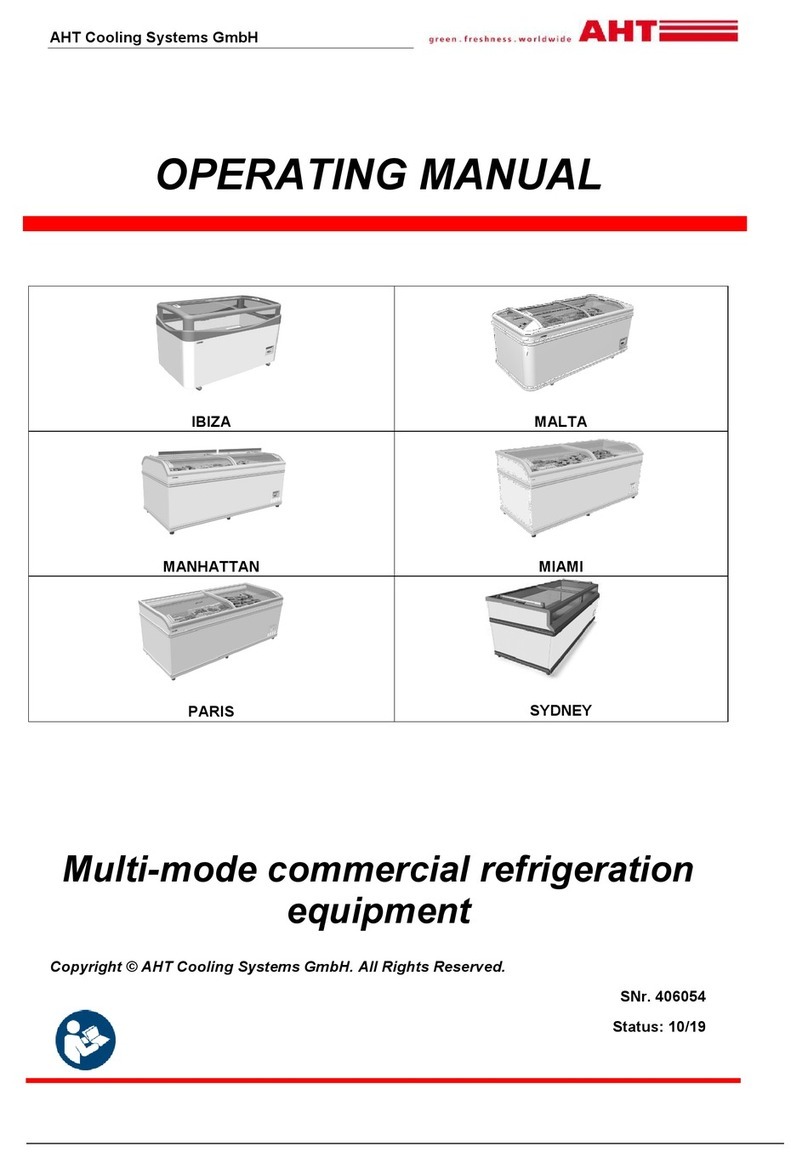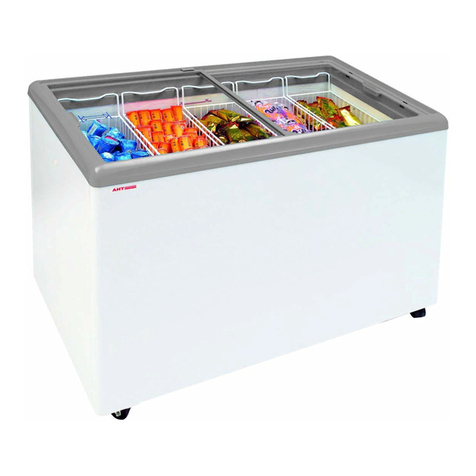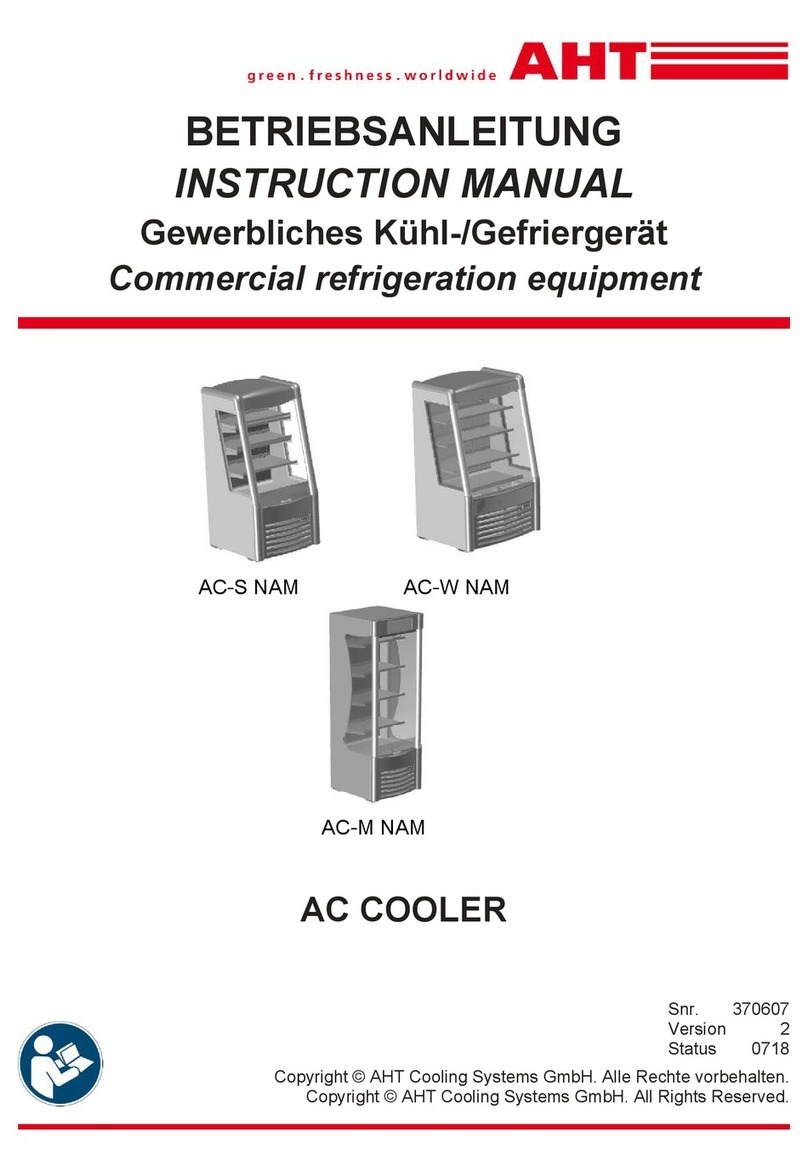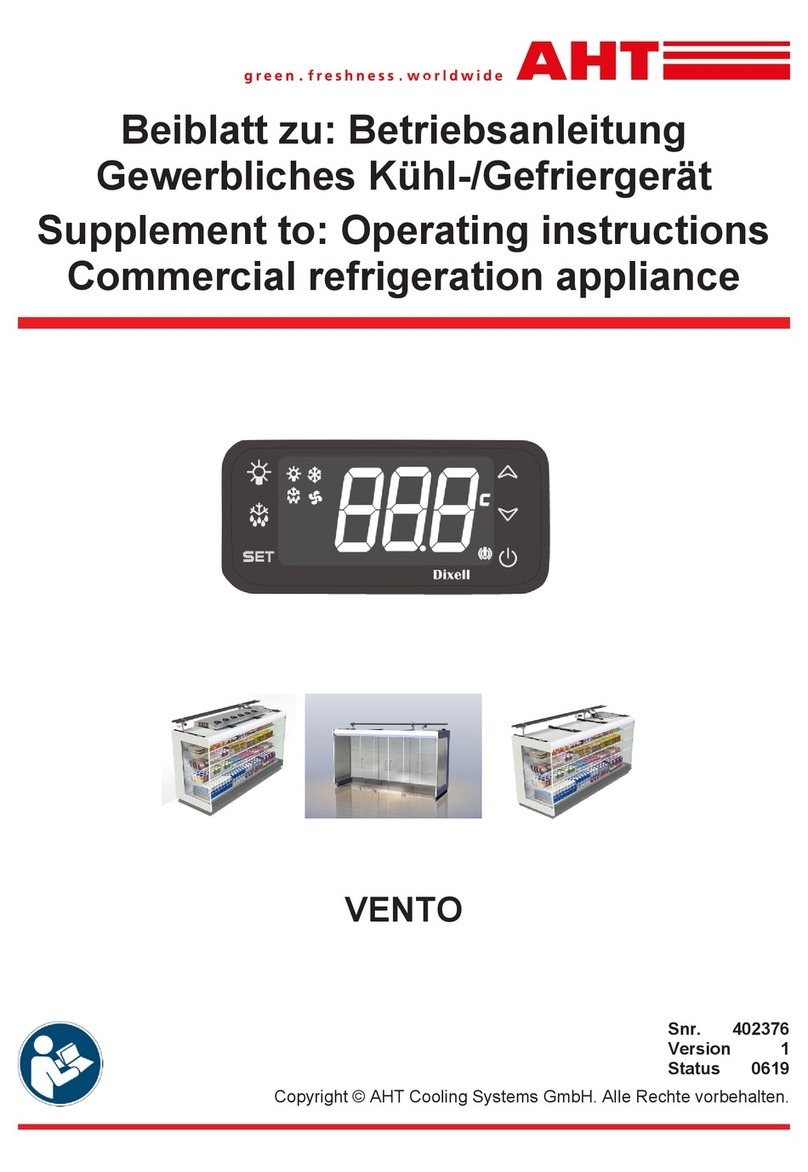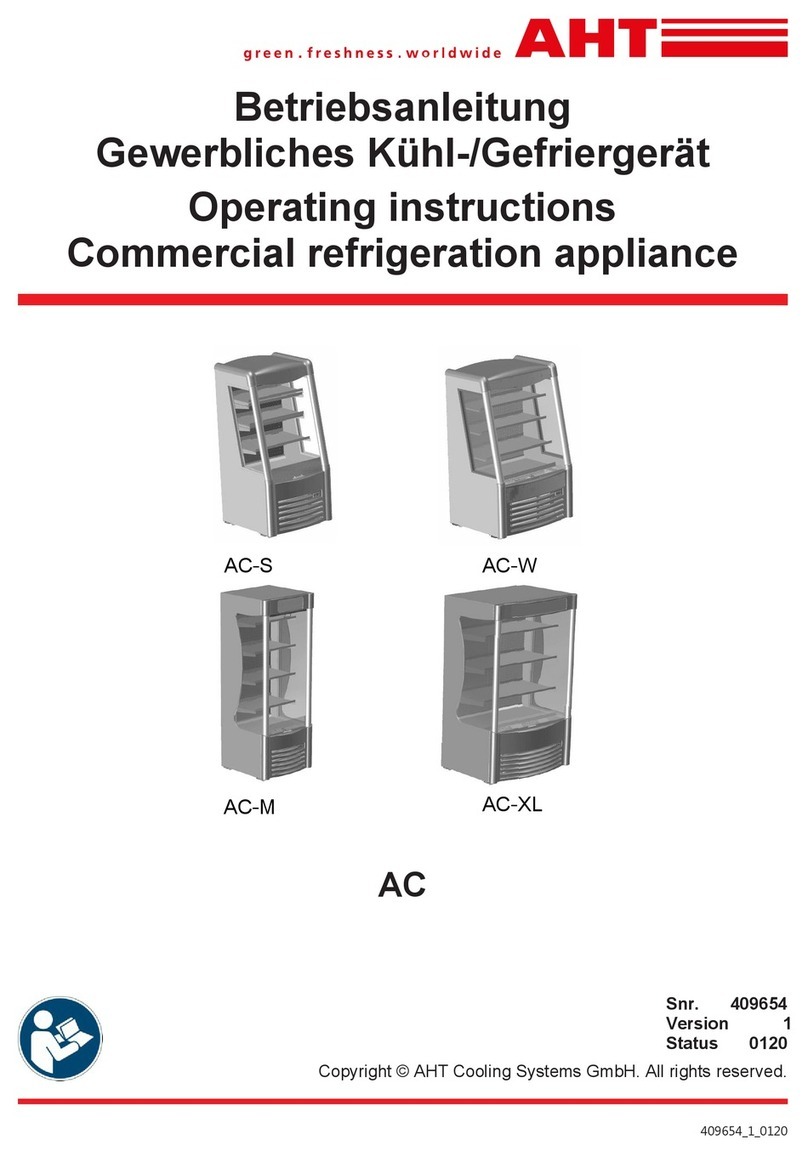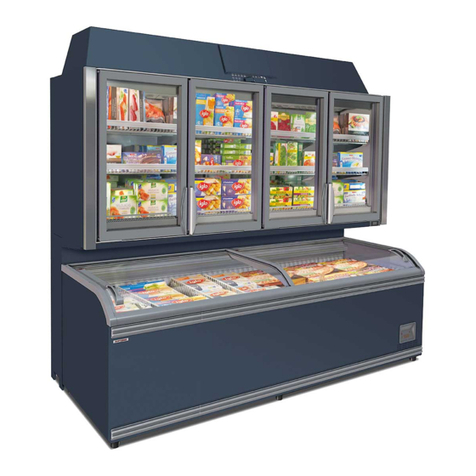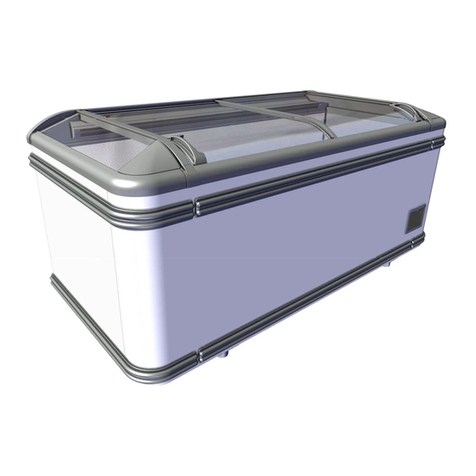
10
AHT Cooling Systems GmbH
1. General Information
Before installing and starting up this unit, any applicable
provision relating to trade law must be observed.
AHT units contain no PCB, PCT, asbestos, formalde-
hyde, cadmium or substances which interfere with wet-
ting.
The refrigerant R404a is covered by the Kyoto Protocol
and has a global warming potential (GWP) of 3784.
2. Rating Plate and Serial Number
The details provided on the “rating plate” must be ob-
served for the installation and maintenance. It is located
on the top on the inside (interior compartment) of the
unit.
Details of the serial number, unit type, refrigerant and
electrical data can be found on the rating plate.
3. Usage
ATTENTION: Do not climb on the unit.
Operate the unit in a temperature range of 16°C
(60.8°F) to a maximum of 25°C (77°F) and in maximum
relative air humidity of 60% in accordance with climate
class 3.
This unit is exclusively for storing and displaying refrig-
erated food products that are packaged or alternatively
filled in bottles or cans.
ATTENTION: Any form of unit usage that dif-
fers from that which is described is considered
to be improper.
Only fill the unit up to the stacking mark at the most
(see Chapter 7). Under no circumstances should you
block the internal ventilation grating; otherwise the air
circulation cannot be maintained.
4. Unpacking and Handling
ATTENTION: To prevent the unit from being
damaged, it may only be transported and stored
when in its usage position. Non-observance of
this requirement will result in a loss of warranty.
If the unit is tilted during transport, then wait at
least 2 hours before starting it up in order to
prevent any damage.
A visual check must be undertaken before and during
unpacking of the unit to check for possible transport
damage. Please look for dents, scratches, etc.
Report any damage to AHT / sales partner immediately.
For the rest, AHT’s terms and conditions apply.
Please check for loose functional parts before disposing
of the packaging material.
5. Installation
ATTENTION: The levelling feet on the bottom must
always be aligned; otherwise there is a risk of
tipping.
ATTENTION: Do not expose the unit to direct
sunlight.
Only use the unit indoors.
Maintain a distance of at least 10cm (3.94”) to the
backwall. Always maintain the stipulated distance
to walls. To do this, mount the supplied wall spacer
on the back of the unit (see installation guide). Placing
the units “back-to-back” without an intermediate wall
is not permitted.
Keep free the air outlets on the upper-/backside of the
unit. Do not store miscellaneous objects on the unit.
There are transport rollers on the bottom of the unit to
make it easier to manipulate (change of location), and
there are levelling feet on the bottom of the front side
to be able to set it up stably (see below).
Levelling foot:
Make sure that the unit is stable and aligned horizon-
tally. To do this, the height of the levelling foot must
be adjusted. The two levelling feet are located on the
bottom of the front side, under the front ventilation
grating, beside the transport rollers. The height of the
plastic-coated levelling foot can be adjusted by turn-
ing it to the left and right (see detailed description be-
low). The unit must not be open during this process.
Detailed description of levelling foot:
Levellin
foot
Height adjustment
Front ventilation grating
Trans
ort rollers
Interior
Product
compartment
Detail
A
Airborne sound emissions of the units < 70 dB(A)
In the event of loud noises and/or strong vibrations in
the unit, contact a service technician.
The weights of the units are given in the datasheets.
They can be obtained from AHT.
The flawless condition of the refrigeration unit and its
proper use must be monitored regularly by the instruc-
ted operating staff. To that effect, the units must be che-
cked to make sure that products that have been stored
there by third parties (improperly) are removed.
Report any damage to AHT / sales partner immediately.
For the rest, AHT’s terms and conditions apply.
Please check for loose functional parts before disposing
of the packaging material.
5. Installation
ATTENTION: The levelling feet on the bottom must
always be aligned; otherwise there is a risk of
tipping.
ATTENTION: Do not expose the unit to direct
sunlight.
Only use the unit indoors.
Maintain a distance of at least 10cm (3.94”) to the
backwall. Always maintain the stipulated distance
to walls. To do this, mount the supplied wall spacer
on the back of the unit (see installation guide). Placing
the units “back-to-back” without an intermediate wall
is not permitted.
Keep free the air outlets on the upper-/backside of the
unit. Do not store miscellaneous objects on the unit.
There are transport rollers on the bottom of the unit to
make it easier to manipulate (change of location), and
there are levelling feet on the bottom of the front side
to be able to set it up stably (see below).
Levelling foot:
Make sure that the unit is stable and aligned horizon-
tally. To do this, the height of the levelling foot must
be adjusted. The two levelling feet are located on the
bottom of the front side, under the front ventilation
grating, beside the transport rollers. The height of the
plastic-coated levelling foot can be adjusted by turn-
ing it to the left and right (see detailed description be-
low). The unit must not be open during this process.
ATTENTION: Do not expose the unit to direct
sunlight.
Only use the unit indoors.
Maintain a distance of at least 10cm (3.94”) to the
backwall. Always maintain the stipulated distance
to walls. To do this, mount the supplied wall spacer
on the back of the unit (see installation guide). Placing
the units “back-to-back” without an intermediate wall
is not permitted.
Keep free the air outlets on the upper-/backside of the
unit. Do not store miscellaneous objects on the unit.
There are transport rollers on the bottom of the unit to
make it easier to manipulate (change of location), and
there are levelling feet on the bottom of the front side
to be able to set it up stably (see below).
Levelling foot:
Make sure that the unit is stable and aligned horizon-
tally. To do this, the height of the levelling foot must
be adjusted. The two levelling feet are located on the
bottom of the front side, under the front ventilation
grating, beside the transport rollers. The height of the
plastic-coated levelling foot can be adjusted by turn-
ing it to the left and right (see detailed description be-
low). The unit must not be open during this process.
Detailed description of levelling foot:
Interior
Product
compartment
Maintain a distance of at least to the backwall. Al-UÊ
ways maintain the stipulated distance to walls.Ê/Ê
`ÊÌÃ]ÊÕÌÊÌiÊÃÕ««i`ÊÜ>Êë>ViÀÊÊÌiÊL>VÊ
vÊ ÌiÊ ÕÌÊ ÃiiÊ ÃÌ>>ÌÊ }Õ`i®°Ê *>V}Ê ÌiÊ ÕÌÃÊ
¹L>VÌL>V»Ê ÜÌÕÌÊ >Ê ÌiÀi`>ÌiÊ Ü>Ê ÃÊ ÌÊ
«iÀÌÌi`°
4. Unpacking and Handling
ATTENTION: To prevent the unit from being
damaged, it may only be transported and stored
when in its usage position. Non-observance of
this requirement will result in a loss of warranty.
If the unit is tilted during transport, then wait at
least 2 hours before starting it up in order to
prevent any damage.
A visual check must be undertaken before and during
unpacking of the unit to check for possible transport
damage. Please look for dents, scratches, etc.
ATTENTION:If the unit is tilted during trans-
port, then wait at least 2 hours before starting it
up in order to prevent any damage.
The details provided on the “rating plate” must be ob-
served for the installation and maintenance. It is located
on the back (outside) of the unit.
Details of the serial number, unit type, refrigerant and
electrical data can be found on the rating plate
.
Operate the unit in a temperature range as shown on
the rating plate












